| Listing 1 - 10 of 29 | << page >> |
Sort by
|
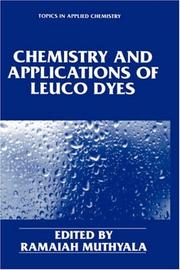
ISBN: 0306454599 9786610043682 1280043687 0306469065 Year: 2002 Publisher: New York : Kluwer Academic Publishers,
Abstract | Keywords | Export | Availability | Bookmark
 Loading...
Loading...Choose an application
- Reference Manager
- EndNote
- RefWorks (Direct export to RefWorks)
Contributions by scientists working in international laboratories provide the novice researcher with synthetic data and high-technology applications of leuco dyes. Covering leuco dye classes that exhibit reasonable stability, the book discusses photochromic materials that have wide-ranging applications in memory technology, leuco dyes for color photography, and a special class of dyes formulated by reduction instead of the oxidation process.
Vat dyes. --- Chemistry, Physical organic. --- Physical Chemistry. --- Physical chemistry. --- Chemistry, Theoretical --- Physical chemistry --- Theoretical chemistry --- Chemistry --- Leuco dyes --- Triphenylmethane dyes --- Dyes and dyeing
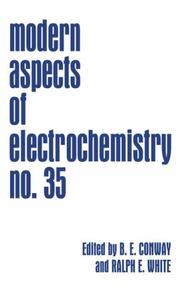
ISBN: 1280200928 9786610200924 0306476045 0306467763 Year: 2002 Publisher: New York, NY : Springer US : Imprint: Springer,
Abstract | Keywords | Export | Availability | Bookmark
 Loading...
Loading...Choose an application
- Reference Manager
- EndNote
- RefWorks (Direct export to RefWorks)
Recognized experts present incisive analyses of both fundamental and applied problems in this continuation of a highly acclaimed series. Topics in Number 35 include: Impedance spectroscopy with specific applications to electrode processes involving hydrogen; Fundamentals and contemporary applications of electroless metal deposition; The development of computational electrochemistry and its application to electrochemical kinetics; Analysis of electrolyte solutions at high concentrations; Applications of the Born theory to solvent polarization by ions and its extensions to treatment of kinetics of ionic reactions. £/LIST£.
Electrochemistry. --- Electrochemical analysis. --- Chemistry. --- Chemistry, Physical organic. --- Physical Chemistry. --- Physical chemistry. --- Chemistry, Theoretical --- Physical chemistry --- Theoretical chemistry --- Chemistry --- Chemistry, Physical and theoretical
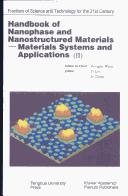
ISBN: 0306483718 038723814X 030647249X 0387335528 Year: 2002 Publisher: New York, NY : Springer US : Imprint: Springer,
Abstract | Keywords | Export | Availability | Bookmark
 Loading...
Loading...Choose an application
- Reference Manager
- EndNote
- RefWorks (Direct export to RefWorks)
These books, with of a total of 40 chapters, are a comprehensive and complete introductory text on the synthesis, characterization, and applications of nanomaterials. They are aimed at graduate students and researchers whose background is chemistry, physics, materials science, chemical engineering, electrical engineering, and biomedical science. The first part emphasizes the chemical and physical approaches used for synthesis of nanomaterials. The second part emphasizes the techniques used for characterizing the structure and properties of nanomaterials, aiming at describing the physical mechanism, data interpretation, and detailed applications of the techniques. The final part focuses on systems of different nanostructural materials with novel properties and applications.
Materials science. --- Physical chemistry. --- Optical materials. --- Electronic materials. --- Materials Science. --- Characterization and Evaluation of Materials. --- Optical and Electronic Materials. --- Physical Chemistry. --- Surfaces (Physics). --- Chemistry, Physical organic. --- Chemistry, Physical organic --- Chemistry, Organic --- Chemistry, Physical and theoretical --- Optics --- Materials --- Physics --- Surface chemistry --- Surfaces (Technology) --- Nanostructured materials --- Chemistry, Theoretical --- Physical chemistry --- Theoretical chemistry --- Chemistry --- Electronic materials --- Material science --- Physical sciences --- Characterization and Analytical Technique. --- Optical Materials. --- Analysis.
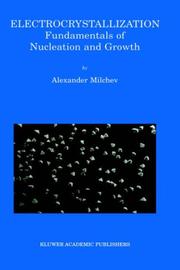
ISBN: 140207090X 0306475529 9786610200399 1280200391 1475776055 Year: 2002 Publisher: New York, New York ; Boston, Massachusetts : Kluwer Academic Publishers,
Abstract | Keywords | Export | Availability | Bookmark
 Loading...
Loading...Choose an application
- Reference Manager
- EndNote
- RefWorks (Direct export to RefWorks)
“Electrocrystallization is a particular case of a first order phase transition” and “Electrocrystallization is a particular case of electrochemical kinetics” are two statements that I have heard and read many times. I do not like them for a simple reason: it is annoying to see that the subject to which you have devoted more than 30 years of your life may be considered as a “particular case”. Therefore, I decided to write this book in which Electrocrystallization is the main subject. To become competent in the field of Electrocrystallization one should possess knowledge of Electrochemistry, Nucleation and Crystal Growth, which means knowledge of Physical Chemistry, Physics and Mathematics. That is certainly difficult and in most cases those who study Electrocrystallization are either more electrochemists, or more physical chemists, or more physicists, very often depending on whom has been their teacher. Of course, there are scientists who consider themselves equally good in all those fields. Very frequently they are, unfortunately, equally bad. The difference is essential but strange enough, it is sometimes not easy to realize the truth immediately.
Crystal growth. --- Nucleation. --- Electrocrystallization. --- Crystal growth --- Nucleation --- Electrocrystallization --- Chemistry. --- Physical chemistry. --- Electrochemistry. --- Crystallography. --- Physical Chemistry. --- Chemistry, Physical organic. --- Crystallography and Scattering Methods. --- Leptology --- Physical sciences --- Mineralogy --- Chemistry, Theoretical --- Physical chemistry --- Theoretical chemistry --- Chemistry --- Chemistry, Physical and theoretical --- Crystals --- Crystallization --- Grain boundaries --- Twinning (Crystallography) --- Electrochemical crystallization --- Electrochemistry --- Growth
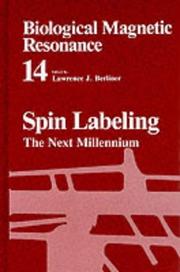
ISBN: 1280206438 9786610206438 0306470721 0306456443 Year: 2002 Publisher: New York, NY : Springer US : Imprint: Springer,
Abstract | Keywords | Export | Availability | Bookmark
 Loading...
Loading...Choose an application
- Reference Manager
- EndNote
- RefWorks (Direct export to RefWorks)
We present here the second issue devoted entirely to the spin-labeling technique as part of Biological Magnetic Resonance. Volume 14 commemorates a modification in our editorial policy with the retirement of my esteemed coeditor, Jacques Reuben. From this juncture into the future, each issue will focus on some special topic in magnetic resonance. Each volume will be organized in most cases by guest editors, for example forthcoming issues will address the following topics: in vivo magnetic resonance (P. Robitaille and L. J. Berliner, eds. ) Modern techniques in proton NMR of proteins (R. Krishna and L. J. Berliner, eds. ) Instrumental techniques of EPR (C. Bender and L. J. Berliner, eds. ) The current volume, Spin Labeling: The Next Millennium, presents an excellent collection of techniques and applications that evolved during the past decade since the last volume, volume 8 (1989). Some obvious omissions, such as multi-quantum EPR and very high-frequency FT-ESR were unfortunately not possible for this volume. Perhaps they will appear in Spin Labeling: 2001. Lastly it is a pleasure to honor two scientists whose contributions were both pioneering and pivotal to the spin label technique: Professor Eduard G. Rozantsev (Moscow), whose synthetic feats in nitroxyl chemistry set the broad stage for a versatile catalog of labels; and Professor Harden M. McConnell, last year's International ESR (EPR) Society Gold Medalist, who conceived and developed the spin label technique to address many biological problems (proteins, enzymes, m- branes, cells, immune response, etc. ). Lawrence J.
Biomolecules --- Magnetic resonance. --- Analysis. --- Chemistry, Physical organic. --- Analytical biochemistry. --- Biochemistry. --- Physical Chemistry. --- Analytical Chemistry. --- Biochemistry, general. --- Physical chemistry. --- Analytical chemistry. --- Biological chemistry --- Chemical composition of organisms --- Organisms --- Physiological chemistry --- Biology --- Chemistry --- Medical sciences --- Analysis, Chemical --- Analytic chemistry --- Chemical analysis --- Chemistry, Analytic --- Chemistry, Theoretical --- Physical chemistry --- Theoretical chemistry --- Composition

ISBN: 1280200529 9786610200528 0306475642 0306472694 Year: 2002 Publisher: New York, NY : Springer US : Imprint: Springer,
Abstract | Keywords | Export | Availability | Bookmark
 Loading...
Loading...Choose an application
- Reference Manager
- EndNote
- RefWorks (Direct export to RefWorks)
Electrometallurgy. --- Electrochemistry. --- Chemistry. --- Materials. --- Surfaces (Physics). --- Chemical engineering. --- Chemistry, Physical organic. --- Metallic Materials. --- Characterization and Evaluation of Materials. --- Industrial Chemistry/Chemical Engineering. --- Physical Chemistry. --- Metals. --- Materials science. --- Physical chemistry. --- Chemistry, Theoretical --- Physical chemistry --- Theoretical chemistry --- Chemistry --- Chemistry, Industrial --- Engineering, Chemical --- Industrial chemistry --- Engineering --- Chemistry, Technical --- Metallurgy --- Material science --- Physical sciences --- Metallic elements --- Chemical elements --- Ores --- Chemistry, Physical and theoretical

ISBN: 1280200545 9786610200542 0306475669 0306465965 Year: 2002 Publisher: New York : Kluwer Academic Publishers,
Abstract | Keywords | Export | Availability | Bookmark
 Loading...
Loading...Choose an application
- Reference Manager
- EndNote
- RefWorks (Direct export to RefWorks)
As quantum theory enters its second century, it is fitting to examine just how far it has come as a tool for the chemist. Beginning with Max Planck’s agonizing conclusion in 1900 that linked energy emission in discreet bundles to the resultant black-body radiation curve, a body of knowledge has developed with profound consequences in our ability to understand nature. In the early years, quantum theory was the providence of physicists and certain breeds of physical chemists. While physicists honed and refined the theory and studied atoms and their component systems, physical chemists began the foray into the study of larger, molecular systems. Quantum theory predictions of these systems were first verified through experimental spectroscopic studies in the electromagnetic spectrum (microwave, infrared and ultraviolet/visible), and, later, by nuclear magnetic resonance (NMR) spectroscopy. Over two generations these studies were hampered by two major drawbacks: lack of resolution of spectroscopic data, and the complexity of calculations. This powerful theory that promised understanding of the fundamental nature of molecules faced formidable challenges. The following example may put things in perspective for today’s chemistry faculty, college seniors or graduate students: As little as 40 years ago, force field calculations on a molecule as simple as ketene was a four to five year dissertation project.
Quantum chemistry. --- Quantum theory. --- Chemistry, Physical organic. --- Chemistry. --- Physical Chemistry. --- Computer Applications in Chemistry. --- Theoretical and Computational Chemistry. --- Physical chemistry. --- Chemoinformatics. --- Chemistry, Physical and theoretical. --- Chemistry, Theoretical --- Physical chemistry --- Theoretical chemistry --- Chemistry --- Chemical informatics --- Chemiinformatics --- Chemoinformatics --- Chemistry informatics --- Information science --- Computational chemistry --- Data processing --- Chemistry, Quantum --- Chemistry, Physical and theoretical --- Quantum theory --- Excited state chemistry
Book
ISBN: 1280205334 9786610205332 030646912X Year: 2002 Publisher: New York, NY : Springer US : Imprint: Springer,
Abstract | Keywords | Export | Availability | Bookmark
 Loading...
Loading...Choose an application
- Reference Manager
- EndNote
- RefWorks (Direct export to RefWorks)
Photochromic materials. --- Photochromism. --- Thermochromism. --- Chemistry. --- Analytical biochemistry. --- Chemistry, inorganic. --- Chemistry, Physical organic. --- Polymers. --- Electrochemistry. --- Analytical Chemistry. --- Inorganic Chemistry. --- Physical Chemistry. --- Polymer Sciences. --- Analytical chemistry. --- Inorganic chemistry. --- Physical chemistry. --- Polymers . --- Polymere --- Polymeride --- Polymers and polymerization --- Macromolecules --- Chemistry, Theoretical --- Physical chemistry --- Theoretical chemistry --- Chemistry --- Inorganic chemistry --- Inorganic compounds --- Analysis, Chemical --- Analytic chemistry --- Chemical analysis --- Chemistry, Analytic --- Chemistry, Physical and theoretical

ISBN: 1280200855 9786610200856 0306475979 0306464659 Year: 2002 Publisher: New York, New York : Kluwer Academic Publishers,
Abstract | Keywords | Export | Availability | Bookmark
 Loading...
Loading...Choose an application
- Reference Manager
- EndNote
- RefWorks (Direct export to RefWorks)
According to R.H. Crabtree, Metal Dihydrogen and sigma-Bond Complexes is described as `the definitive account of twentieth-century work in the area of sigma complexation'. It covers not only Kubas' discovery of dihydrogen coordination and the study of its structure and general properties but also discusses both the theoretical beliefs and experimental results of bonding and activation of dihydrogen on metal centers and the coordination and activation of C-H, B-H, X-H, and X-Y bonds, giving an overview of `one of the hottest areas in chemistry'.
Metal complexes. --- Hydrogen. --- Chemical bonds. --- Chemistry, Organic. --- Chemistry, Physical organic. --- Chemistry, inorganic. --- Chemical engineering. --- Organometallic Chemistry. --- Physical Chemistry. --- Inorganic Chemistry. --- Industrial Chemistry/Chemical Engineering. --- Organometallic chemistry . --- Physical chemistry. --- Inorganic chemistry. --- Chemistry, Industrial --- Engineering, Chemical --- Industrial chemistry --- Engineering --- Chemistry, Technical --- Metallurgy --- Inorganic chemistry --- Chemistry --- Inorganic compounds --- Chemistry, Theoretical --- Physical chemistry --- Theoretical chemistry --- Chemistry, Organometallic --- Metallo-organic chemistry --- Chemistry, Organic --- Nonmetals
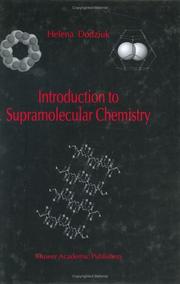
ISBN: 1280200758 9786610200757 0306475871 1402002149 Year: 2002 Publisher: Dordrecht : Springer Netherlands : Imprint: Springer,
Abstract | Keywords | Export | Availability | Bookmark
 Loading...
Loading...Choose an application
- Reference Manager
- EndNote
- RefWorks (Direct export to RefWorks)
A new rapidly progressing field on the crossroads among chemistry, biochemistry, physics and technology - supramolecular chemistry - has just emerged. You have to be involved, to know what's going on in this domain and to take part in the development. This book will show you in a condensed form exciting phenomena unthinkable within the realm of classical organic chemistry (for example, alkali metal anions or cyclobutadiene stable for month at room temperature) that not only provide the basis for revolutionizing numerous branches of industry but also improve our understanding of the functioning of living organisms and of the origin of life. Designing supramolecular systems with desired properties will among others make chemical industry cleaner and more safe, electronics smaller by developing devices composed of single molecule or molecular aggregate. It will also entirely change the way we use energy resources. In addition, it will also transform the pharmaceutical industry and medicine by developing new ways of drugs administration and new composite biocompatible materials which will serve as implants of new generation changing dentistry, surgery, and other branches of medicine. You cannot afford to stand apart. With its brief but comprehensive and vivid presentation including the latest development, Introduction to Supramolecular Chemistry is the best method to get into this domain. This book provides an excellent summary of information scattered across the literature. The brief but comprehensive coverage of the whole field including practically all important group of compounds forming aggregates (in particular crown ethers, cavitands, fullerenes, cyclodextrins and their complexes) provisioning full references for the discussed subjects make this book of value not only for Ph.D. students and non-specialists in this domain but also for those working in the field. The book has been found to be a particularly useful resource for students and more generally for those wanting to get the up-to-date concise account of this exciting field.
Supramolecular chemistry. --- Supramolecular electrochemistry. --- Chemistry, Physical organic. --- Surfaces (Physics). --- Analytical biochemistry. --- Chemistry. --- Physical Chemistry. --- Characterization and Evaluation of Materials. --- Analytical Chemistry. --- Chemistry/Food Science, general. --- Physical chemistry. --- Materials science. --- Analytical chemistry. --- Physical sciences --- Analysis, Chemical --- Analytic chemistry --- Chemical analysis --- Chemistry, Analytic --- Chemistry --- Material science --- Chemistry, Theoretical --- Physical chemistry --- Theoretical chemistry
| Listing 1 - 10 of 29 | << page >> |
Sort by
|

 Search
Search Feedback
Feedback About
About Help
Help News
News